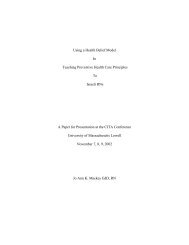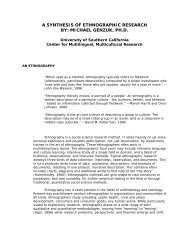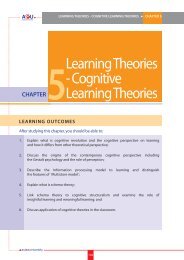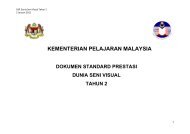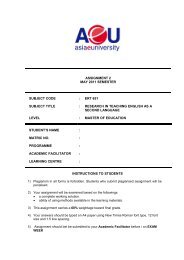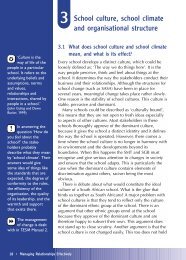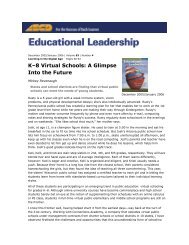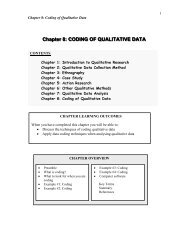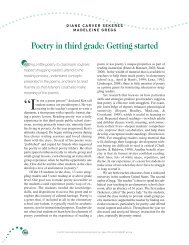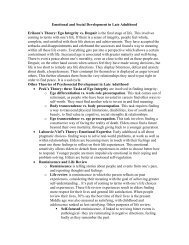of <strong>for</strong>ms" (Larsen-Freeman, 1997, p. 155) ignores the fact that "we have nomechanism <strong>for</strong> decid<strong>in</strong>g which of the phenomena described or reported to be carriedout by the learner are <strong>in</strong> fact those that lead to language acquisition" (Seliger, 1984, p.37), as well as the fact that the learner's <strong>in</strong>ternal grammar is not a steady commodityand often deteriorates prior to <strong>in</strong>ternaliz<strong>in</strong>g new content. Even if we could identifyand measure all of the factors <strong>in</strong> second language acquisition, complexity theory tellsus that "we would still be unable to predict the outcome of their comb<strong>in</strong>ation"(Larsen-Freeman, 1997, p. 157).Psychologists and educators still know little about how language learn<strong>in</strong>g occurs,and why and how some <strong>in</strong>dividuals are more competent than others, so that it is<strong>in</strong>appropriate to def<strong>in</strong>e and test discrete symptoms of the process. However,observable factors that appear to be associated with learn<strong>in</strong>g <strong>in</strong>clude construction ofmean<strong>in</strong>g, shar<strong>in</strong>g of experiences, identification of needs and purposes, criticalevaluation of per<strong>for</strong>mance strategies, and awareness of this process (Harri-Augste<strong>in</strong>& Thomas, 1991, p. 7). These factors can be satisfactorily exam<strong>in</strong>ed (from the po<strong>in</strong>tof view of both teacher and student) us<strong>in</strong>g reflective, authentic assessment methods <strong>in</strong>appropriate learner-centered classroom activities. Integrated <strong>in</strong>to the day-to-daycurriculum, assessment can become both a means and an end, and considerations ofvalidity, reliability and efficiency cease to be a major issue <strong>in</strong> the ongo<strong>in</strong>g reflectiveself-exam<strong>in</strong>ation of language per<strong>for</strong>mance.III. CRITERION-REFERENCED/NORM-REFERENCED TESTING<strong>Authentic</strong> assessment <strong>in</strong> a task-based process sett<strong>in</strong>g implies a focus on languagemastery (criterion-referenced per<strong>for</strong>mance) rather than relative per<strong>for</strong>mance(norm-referenced per<strong>for</strong>mance), a focus which Ames and Archer (1988) found to behighly motivat<strong>in</strong>g <strong>in</strong> the classroom, foster<strong>in</strong>g long-term use of learn<strong>in</strong>g strategies andhelp<strong>in</strong>g students <strong>for</strong>m realistic but challeng<strong>in</strong>g goals. When relative per<strong>for</strong>mance wasthe goal however, learners believed that ability was shown by success with little ef<strong>for</strong>t,and they judged their ability lower. As Darl<strong>in</strong>g-Hammond (1994, p. 110) po<strong>in</strong>ts out,assessment needs to support authentic <strong>for</strong>ms of teach<strong>in</strong>g and learn<strong>in</strong>g.Task-based process assessment <strong>in</strong>volves a criterion-referenced orientation, withCriterion-Referenced Tests (CRTs) provid<strong>in</strong>g direct <strong>in</strong><strong>for</strong>mation "about what thelearner can actually do with the target language." (McClean, 1995, p. 137). Strengthsand weaknesses can be isolated across the whole test population, and specific<strong>in</strong><strong>for</strong>mation can be ga<strong>in</strong>ed about an <strong>in</strong>dividual's per<strong>for</strong>mance, <strong>in</strong> contrast toNorm-Related Tests (NRTs), which tend to give <strong>in</strong><strong>for</strong>mation only about learners ateither ends of the scale (cf. McClean, 1995, p. 146; Cartier, 1968; Cziko, 1982;Hudson & Lynch, 1984; Brown, 1988; 1989; Bachman, 1989; 1990).Brown (1995) classifies CRTs and NRTs accord<strong>in</strong>g to their test characteristics andlogistical dimensions (Table 2, below). as can be seen from this table, CRTs areappropriate <strong>for</strong> assessment of oral <strong>for</strong>eign language per<strong>for</strong>mance, <strong>in</strong> that they fosterlearn<strong>in</strong>g (learn<strong>in</strong>g how to learn), they are classroom specific, and they are <strong>for</strong>mative,be<strong>in</strong>g concerned with ongo<strong>in</strong>g needs analysis and the feedback of relevant data <strong>in</strong>tothe learn<strong>in</strong>g process. In contrast, NRTs are concerned with the adm<strong>in</strong>istration of thelearners, and are summative <strong>in</strong> nature, assess<strong>in</strong>g whether learners have been (or arelikely to be) successful (however this is def<strong>in</strong>ed), but unable to comment on why orhow, or on what should happen next (cf. Williams & Burden, 1994, p. 22). NRTs thusdiffer from CRTs <strong>in</strong> focus, tim<strong>in</strong>g, purpose and theoretical motivation and reflectdifferent perspectives and goals. :TABLE 2
Differences between NRTS and CRTS (Brown, 1995, p.12).CRTsNRTsTest CharacteristicsUnderly<strong>in</strong>g Purposes Foster learn<strong>in</strong>g Classify/group studentsTypes of Decisions Diagnosis, progress,Aptitude, proficiency, placementachievementLevels of Generality Classroom specific Overall, globalStudents' Expectations Know content to expect Do not know contentScore Interpretations Percent PercentileScore Report Strategies Tests and answers to students Only scores go to studentsLogistical DimensionsGroup Size Relatively small group Large groupRange of Abilities Relatively homogeneous Wide range of abilitiesTest Length Relatively few questions Large number of questionsTime Allocated Relatively short time Long (2-4 hours) adm<strong>in</strong>istrationCost Teacher time & duplication Test booklets, tapes, proctorIV. THE KOREAN SITUATION1. The 7th CurriculumThe advocation of CRTs, and <strong>in</strong> particular of authentic assessment, <strong>in</strong> tertiary <strong>EFL</strong>classrooms <strong>in</strong> Korea, is especially appropriate <strong>in</strong> the light of the goals of schooleducation as stated <strong>in</strong> section 1 ("The direction of curriculum design") of the KoreanM<strong>in</strong>istry of Education 7th Curriculum document (박, 2001, p. 3). Here we f<strong>in</strong>d the idealof 홍익인간 (hongik-<strong>in</strong>gan: contribut<strong>in</strong>g to the overall benefit of humank<strong>in</strong>d) at thefoundation of educational objectives which aim to foster "the ability to achieve an<strong>in</strong>dependent life and acquire the qualifications of democratic citizens, and to be able toparticipate <strong>in</strong> the build<strong>in</strong>g of a democratic state and promot<strong>in</strong>g the prosperity of allhumank<strong>in</strong>d" (박, 2001, p. 3). The well-educated person that these goals aim topromote is further def<strong>in</strong>ed as:1.A person who seeks to develop his/her own <strong>in</strong>dividuality on the basis ofwell-rounded and wholesome development2.A person who demonstrates creative ability on the basis of a solid ground<strong>in</strong>g <strong>in</strong>basic knowledge and skills3.A person who explores career paths on the basis of broad <strong>in</strong>tellectualknowledge and skills <strong>in</strong> diverse academic discipl<strong>in</strong>es4.A person who creates new values on the basis of an understand<strong>in</strong>g of thenational culture5.A person who contributes to the development of the community where he/shelives on the basis of democratic citizenship. (박, 2001, p. 4)Such a humanistic, holistic view of education provides an excellent reference-po<strong>in</strong>t<strong>for</strong> curriculum designers and school teachers when consider<strong>in</strong>g learn<strong>in</strong>g environments,curriculum content, and assessment models, <strong>for</strong> it is immediately apparent that thepromotion of responsible, creative <strong>in</strong>dividuals with critical th<strong>in</strong>k<strong>in</strong>g skills andawareness of professional ethics (the sort of people who will contribute actively andconstructively to society <strong>in</strong> the 21st century), is not to be (and has not been)achieved through the norm-referenced assessment model, which is evidently



